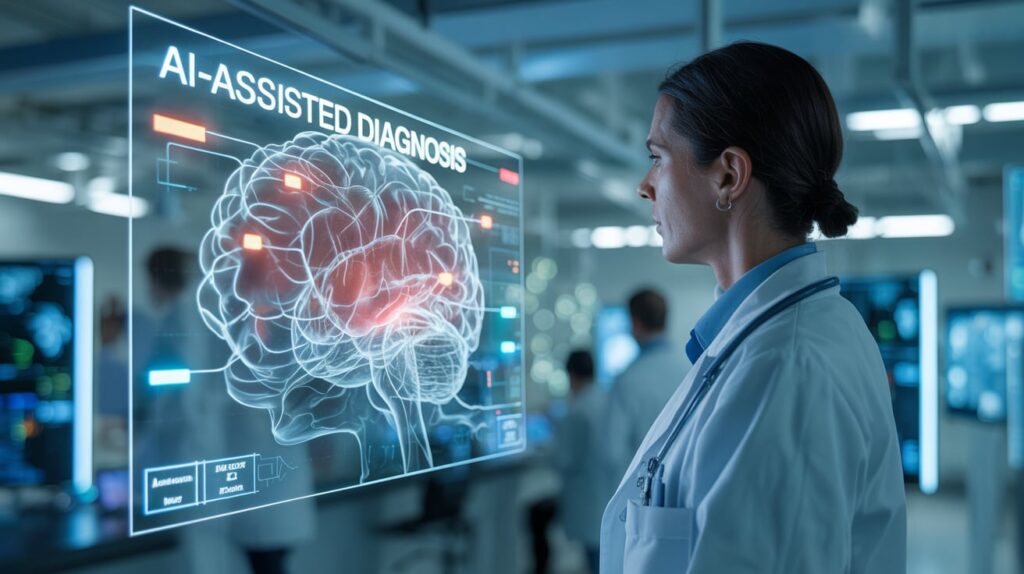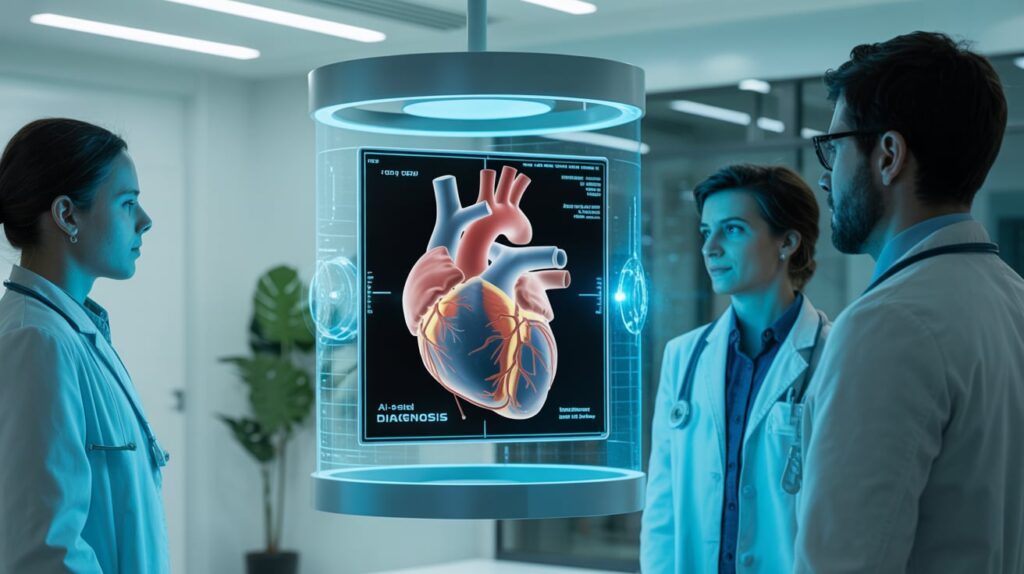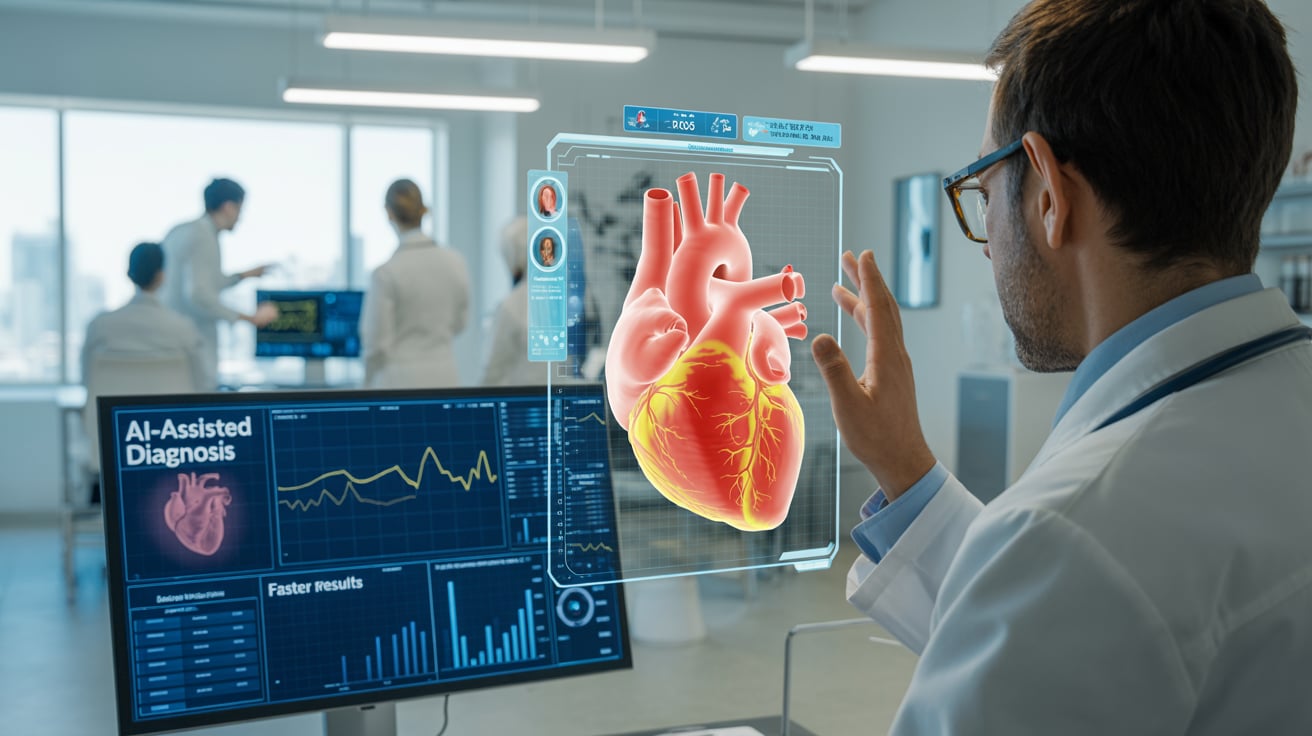Artificial Intelligence (AI) is no longer a futuristic concept—it’s already transforming industries, and one of the most impactful areas is healthcare. Among its many applications, AI is proving especially valuable in helping medical professionals achieve faster and more accurate diagnoses. From analyzing scans and lab results to predicting disease risks before symptoms appear, AI is becoming a trusted partner in the fight against illness.
In this article, we’ll explore how AI is reshaping healthcare diagnostics, the technologies behind it, real-world examples, benefits, challenges, and what the future holds.
Why Speed Matters in Healthcare Diagnosis
Accurate and timely diagnosis is the foundation of effective treatment. Unfortunately, delays are common due to:
- Shortages of medical professionals
- Overwhelmed hospital systems
- Human error in interpreting complex results
- Time-consuming manual analysis of tests and scans
For conditions like cancer, stroke, or infectious diseases, even a short delay can mean the difference between successful treatment and severe consequences. This is where AI’s ability to process vast amounts of data quickly makes it invaluable.
ALSO CHECK: Best Photo Editing Apps Powered by AI in 2025
How AI Assists in Faster Diagnosis
AI-powered systems excel at recognizing patterns, interpreting images, and analyzing data at speeds far beyond human capabilities. Here’s how they are currently being applied:

1. Medical Imaging and Radiology
Radiology is one of the first fields to see widespread AI adoption. AI algorithms can scan X-rays, MRIs, CT scans, and ultrasounds, identifying anomalies like tumors, fractures, or blood clots.
- Example: AI systems trained on thousands of mammograms can detect early signs of breast cancer with accuracy comparable to expert radiologists.
- Benefit: Reduces waiting time for results and minimizes the chances of missed diagnoses.
2. Pathology and Lab Testing
AI can analyze blood tests, biopsy samples, and genetic data to find indicators of disease. Machine learning models identify abnormal cell structures or chemical imbalances much faster than manual methods.
- Example: AI tools can flag abnormal white blood cell counts linked to leukemia, allowing doctors to act quickly.
3. Predictive Diagnostics
By analyzing patient history, lifestyle data, and genetic markers, AI predicts the likelihood of developing diseases such as diabetes, heart conditions, or neurological disorders.
- Example: Wearable devices powered by AI track heart rhythms and alert doctors about irregularities that may indicate atrial fibrillation before a major cardiac event.
4. Electronic Health Records (EHRs)
AI systems sift through massive volumes of patient records to identify connections between symptoms, medications, and conditions. This helps doctors reach diagnoses faster, without combing through years of patient history manually.
- Benefit: Saves doctors hours of work and reduces missed details hidden in unstructured data.
5. Point-of-Care Diagnostics
Portable AI-powered diagnostic devices allow quick testing in clinics, rural areas, or even at home. These devices deliver results within minutes.
- Example: AI-driven COVID-19 test kits provided rapid diagnosis during the pandemic, reducing strain on hospitals.

6. Natural Language Processing (NLP)
AI can “read” and understand medical literature, research papers, and case studies. By cross-referencing symptoms with the latest knowledge, AI provides physicians with diagnostic suggestions based on cutting-edge medical research.
Real-World Examples of AI in Faster Diagnosis
- Google DeepMind & Eye Disease
DeepMind developed an AI system that can detect over 50 eye diseases from retinal scans with the same accuracy as leading specialists. - IBM Watson for Oncology
Watson analyzes patient data and medical literature to recommend cancer treatment plans, helping oncologists make quicker decisions. - IDx-DR for Diabetic Retinopathy
This FDA-approved AI tool screens for diabetic retinopathy by analyzing eye images, allowing early detection and treatment. - PathAI
Used in pathology labs, PathAI improves the accuracy and speed of diagnosing cancers by analyzing tissue samples.
Benefits of AI in Faster Diagnosis
- Reduced Diagnostic Errors: AI helps minimize human error in interpreting scans and lab tests.
- Efficiency and Speed: Results are processed in minutes, reducing wait times for patients.
- Scalability: AI assists overburdened healthcare systems by handling routine analyses.
- Personalized Medicine: AI considers genetic and lifestyle data to tailor diagnosis and treatment to individuals.
- Accessibility: Rural and underserved communities benefit from AI-enabled portable diagnostic devices.
Challenges and Concerns
While AI is revolutionizing healthcare, it also faces challenges:
- Data Privacy: Medical data is highly sensitive. AI systems must ensure strict security and compliance.
- Bias in Algorithms: If AI is trained on biased data, it may lead to inaccurate diagnoses for certain populations.
- Dependence on Technology: Overreliance on AI could reduce critical thinking among medical professionals.
- Regulatory Hurdles: AI systems need rigorous testing and approval from health authorities before deployment.
- Integration with Workflows: Hospitals and clinics must adapt existing systems to work seamlessly with AI tools.
The Human-AI Partnership
It’s important to note that AI is not replacing doctors—it’s augmenting their capabilities. Physicians provide context, empathy, and decision-making that machines cannot replicate. AI acts as a second opinion or a fast assistant, ensuring that doctors can spend more time with patients rather than buried in paperwork or routine analyses.
For example, instead of spending hours analyzing radiology scans, doctors can focus on discussing treatment options and patient care, relying on AI to flag any abnormalities.

Future of AI in Diagnostics
By 2030, experts predict AI will be integrated into nearly every aspect of healthcare diagnostics. Some future possibilities include:
- Real-Time Diagnosis: Wearables and smart implants that continuously monitor health and alert patients and doctors instantly.
- Global Databases: Shared AI systems that learn from millions of cases worldwide to improve accuracy.
- Holistic Health Profiles: AI combining physical, genetic, and lifestyle data to detect risks before symptoms appear.
- Self-Diagnosis Tools: Advanced consumer apps guiding people to seek medical help sooner.
These developments could mean earlier detection of life-threatening conditions, saving countless lives.
Final Thoughts
AI is proving to be a game-changer in healthcare diagnostics. From radiology to pathology and predictive analytics, it helps doctors reach faster and more accurate conclusions. While challenges such as data privacy, bias, and regulation need attention, the benefits far outweigh the drawbacks.
In the near future, AI will not only assist in diagnosis but will also enable continuous health monitoring, early prevention, and highly personalized treatment. Instead of replacing doctors, AI empowers them to deliver better care in less time, ultimately improving patient outcomes across the globe.
As healthcare systems strive to balance growing demands with limited resources, AI offers a powerful solution—ensuring that the right diagnosis comes at the right time.


Artificial intelligence holds the potential to undermine human creativity if not used responsibly. While AI-generated videos are becoming increasingly sophisticated and producing realistic visuals, their indiscriminate use needs to be approached with caution. It is essential to carefully evaluate each case to decide if AI-generated content should be used or not.
As AI technology continues to advance, the ability to create lifelike videos and images will become more accessible, raising concerns about authenticity. One immediate consequence of this development is the erosion of trust in visual media. When AI can seamlessly fabricate realistic images and videos, people may begin to question the authenticity of even the most genuine photographs or footage. This could lead to a loss of the emotional connection and personal significance that real images and videos once held, as they may no longer be seen as reliable representations of truth. This is a dangerous trend.
In essence, the increasing capability of AI to replicate reality poses a challenge to the value people place on genuine, unaltered content. If misused, it could shift how people perceive the world around , distorting our understanding of what is real and what is fabricated.
That to a kids developing mind impact may be even more subtle and can do far-reaching consequences.
If a ritual, tradition, idea or doctrine is ingrained from early childhood, it tends to persist. Once something becomes #canonical#, it is generally accepted as unchangeable. Understanding what is canonical is crucial; once an image, object, concept, or practice is deemed canonical, it becomes unquestionable.
For instance, if someone is required to sacrifice a buffalo during a festival, they will do so without questioning animal’s suffering. They perform the act joyfully, regardless of whether the buffalo is frightened or happy. The individuals sacrificing the buffalo may not necessarily cruel; they are simply partaking to a ritual and enjoying.
Similarly, a butcher in a butchery learns the trade at a young age and, due to the routine nature of the work, may overlook the compassion aspect. Butchers are not inherently heartless; they are following a long-running practice from generation to generation. Ironically, once a ritual gains widespread acceptance, it becomes very difficult, if not impossible, to abandon it.
Another aspect of human nature is that the more one is urged to abandon a ritual or belief, the more attached they may become. For example, if no one is observing the festival of Easter, criticizing it may lead to increased participation. Likewise, if people stop reading the Bible or Torah or their favorite Fairy book, controversy surrounding them may prompt others to read them to counter the criticism. The scripture remains valid, since it is canonical. A canonicalized stuff can not be altered.
It is important to recognize that canonical beliefs or rituals are resistant to change. People often focus on the positive aspects of life while ignoring the negative. When navigating through any city, town, or village, one encounters both pleasant and unpleasant areas, but this does not lead to a rejection of the entire city. Instead, people gravitate toward the more appealing neighborhoods. The same principle applies to scriptures; if a text contains numerous uplifting passages but a few negative ones, it is unlikely to be discarded as whole.
If a ritual, tradition, or idea is ingrained from early childhood, it tends to persist. Once something becomes canonical, it is generally accepted as unchangeable. Understanding what is canonical is crucial; once an image, object, concept, or practice is deemed canonical, it becomes unquestionable.
For instance, if someone is required to sacrifice a buffalo during a festival, they will do so without considering the animal’s suffering. They perform the act joyfully, regardless of whether the buffalo is frightened or content. The individual sacrificing the buffalo is not necessarily cruel; they are simply adhering to a tradition.
Similarly, a butcher learns the trade at a young age and, due to the routine nature of the work, may overlook the compassion aspect. Butchers are not inherently heartless; they are following a customary practice. Ironically, once a ritual gains widespread acceptance, it becomes challenging, if not impossible, to abandon it.
Another aspect of human nature is that the more one is urged to abandon a ritual or belief, the more attached they may become. For example, if no one is observing the festival of Rakhi, criticizing it may lead to increased participation. Likewise, if people stop reading the Vedas or Manusmriti, controversy surrounding them may prompt others to read them to counter the criticism. The scripture remains valid, as it is canonical.
It is important to recognize that canonical beliefs or rituals are resistant to change. People often focus on the positive aspects of life while ignoring the negative. When navigating through any city, town, or village, one encounters both pleasant and unpleasant areas, but this does not lead to a rejection of the entire city. Instead, people gravitate toward the more appealing neighborhoods. The same principle applies to scriptures; if a text contains numerous uplifting passages but a few negative ones, it is unlikely to be discarded. If a canonical idea is positive, it will be embraced; if it is negative, it may still be retained.
If a ritual, tradition, or idea is ingrained from early childhood, it tends to persist. Once something becomes canonical, it is generally accepted as unchangeable. Understanding what is canonical is crucial; once an image, object, concept, or practice is deemed canonical, it becomes unquestionable.
For instance, if someone is required to sacrifice a buffalo during a festival, they will do so without considering the animal’s suffering. They perform the act joyfully, regardless of whether the buffalo is frightened or content. The individual sacrificing the buffalo is not necessarily cruel; they are simply adhering to a tradition.
Similarly, a butcher learns the trade at a young age and, due to the routine nature of the work, may overlook the compassion aspect. Butchers are not inherently heartless; they are following a customary practice. Ironically, once a ritual gains widespread acceptance, it becomes challenging, if not impossible, to abandon it.
Another aspect of human nature is that the more one is urged to abandon a ritual or belief, the more attached they may become. For example, if no one is observing the festival of Rakhi, criticizing it may lead to increased participation. Likewise, if people stop reading the Vedas or Manusmriti, controversy surrounding them may prompt others to read them to counter the criticism. The scripture remains valid, as it is canonical.
It is important to recognize that canonical beliefs or rituals are resistant to change. People often focus on the positive aspects of life while ignoring the negative. When navigating through any city, town, or village, one encounters both pleasant and unpleasant areas, but this does not lead to a rejection of the entire city. Instead, people gravitate toward the more appealing neighborhoods. The same principle applies to scriptures; if a text contains numerous uplifting passages but a few negative ones, it is unlikely to be discarded. If a canonical idea is positive, it will be embraced; if it is negative, it may still be retained.